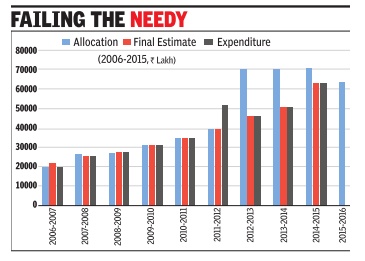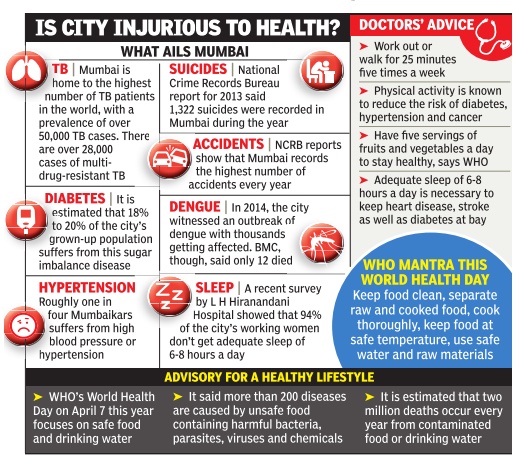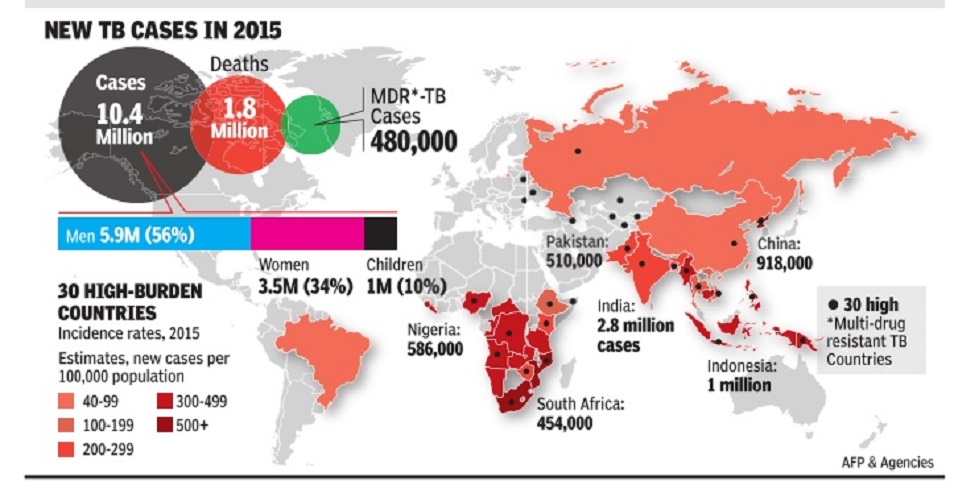Tuberculosis (TB ): India
m (Pdewan moved page TB Tuberculosis:India to Tuberculosis (TB ): India without leaving a redirect) |
(→2014: Drug resistant patients) |
||
| Line 71: | Line 71: | ||
According to health ministry data, 170 new cases of tuberculosis per lakh population are reported every year.Though it has come down over the past decade, it is still significant with a prevalence of 211 cases per lakh people. | According to health ministry data, 170 new cases of tuberculosis per lakh population are reported every year.Though it has come down over the past decade, it is still significant with a prevalence of 211 cases per lakh people. | ||
| − | =2014: Drug resistant patients= | + | =Resurgent tuberculosis= |
| + | ==2014: Drug resistant patients== | ||
[http://epaperbeta.timesofindia.com//Article.aspx?eid=31808&articlexml=Mum-tops-in-drug-resistant-TB-patients-06042015011038 ''The Times of India''] | [http://epaperbeta.timesofindia.com//Article.aspx?eid=31808&articlexml=Mum-tops-in-drug-resistant-TB-patients-06042015011038 ''The Times of India''] | ||
[[File: 2014 Drug resistant patients.jpg|2014: Drug resistant patients|frame|500px]] | [[File: 2014 Drug resistant patients.jpg|2014: Drug resistant patients|frame|500px]] | ||
| Line 81: | Line 82: | ||
If it's Mumbai, it must be easy to spot a construction site, hail a cab or buy a delicious doughnut.But the related health cost -of the super-fine construction-related dust, the highdecibel honking and sugar -may not be easy to spot. The stress and strain of living in Mumbai, say doctors, means it is home to the largest chunk of drug-resistant tuberculosis patients in the world as well as the highest number of diabetics in the country . | If it's Mumbai, it must be easy to spot a construction site, hail a cab or buy a delicious doughnut.But the related health cost -of the super-fine construction-related dust, the highdecibel honking and sugar -may not be easy to spot. The stress and strain of living in Mumbai, say doctors, means it is home to the largest chunk of drug-resistant tuberculosis patients in the world as well as the highest number of diabetics in the country . | ||
| + | |||
Dr Hemant Thacker, who consults at Jaslok Hospital, Pedder Road, said, “Living in Mumbai is a challenge but it is also rewarding because Mumbaikars are innovating every day . They innovate to fight the challenges of modern lifestyle luxuries that give birth to lifestyle diseases -ranging from metabolic syndrome due to excess of salt, sugar and butter to pollution-induced problems of the lungs, and mosquitoes.“ The city recorded its worst outbreak of dengue in 2014, which affected thousands and killed 12. Mumbai records the country's highest number of accidents (at roughly 25,000 a year) and is third on the suicide chart. | Dr Hemant Thacker, who consults at Jaslok Hospital, Pedder Road, said, “Living in Mumbai is a challenge but it is also rewarding because Mumbaikars are innovating every day . They innovate to fight the challenges of modern lifestyle luxuries that give birth to lifestyle diseases -ranging from metabolic syndrome due to excess of salt, sugar and butter to pollution-induced problems of the lungs, and mosquitoes.“ The city recorded its worst outbreak of dengue in 2014, which affected thousands and killed 12. Mumbai records the country's highest number of accidents (at roughly 25,000 a year) and is third on the suicide chart. | ||
| Line 88: | Line 90: | ||
On the occasion of World Health Day on April 7 (Tuesday), the World Health Organisation has called for better safety rules for food and water. Endocrinologist Dr Shashank Joshi from Lilavati Hospital, Bandra, said, “My wish list for a healthy Mumbai would be to be able to drink water from the tap like in American cities.The food quality across the city should be so uniform that people who consume it wouldn't fall prey to infectious diseases such as gastroenteritis, jaundice or typhoid.'' Another condition that liver specialists like Dr Samir Shah fear could become an epidemic is non-alcoholic fatty liver disease. “Dietary sugar can damage your liver very much the same way that alcohol can. At its most severe, non-alcoholic fatty liver disease (NAFLD) can progress to dysfunction of the liver or liver failure. It is estimated around 32% of Indian populace is affected by fatty liver ailment.“ NAFLD is mainly caused by obesity, Type 2 diabetes and metabolic syndrome. | On the occasion of World Health Day on April 7 (Tuesday), the World Health Organisation has called for better safety rules for food and water. Endocrinologist Dr Shashank Joshi from Lilavati Hospital, Bandra, said, “My wish list for a healthy Mumbai would be to be able to drink water from the tap like in American cities.The food quality across the city should be so uniform that people who consume it wouldn't fall prey to infectious diseases such as gastroenteritis, jaundice or typhoid.'' Another condition that liver specialists like Dr Samir Shah fear could become an epidemic is non-alcoholic fatty liver disease. “Dietary sugar can damage your liver very much the same way that alcohol can. At its most severe, non-alcoholic fatty liver disease (NAFLD) can progress to dysfunction of the liver or liver failure. It is estimated around 32% of Indian populace is affected by fatty liver ailment.“ NAFLD is mainly caused by obesity, Type 2 diabetes and metabolic syndrome. | ||
| + | ==2015: South Asia among problem regions== | ||
| + | [[File: Tuberculosis in South Asia and the world, 2015.jpg| Tuberculosis in South Asia and the world, 2015. China, India and Pakistan have been mentioned on this map. However, Bangladesh seems to be as badly affected, and Myanmar much worse. |frame|500px]] | ||
| + | |||
| + | [http://epaperbeta.timesofindia.com/Article.aspx?eid=31808&articlexml=INDIA-AMONG-SIX-NATIONS-WITH-60-NEW-TB-15102016038008 Oct 15 2016 : The Times of India, INDIA AMONG SIX NATIONS WITH 60% NEW TB CASES] | ||
| + | [[Category:Bangladesh |T ]] | ||
| + | [[Category:China |T ]] | ||
| + | [[Category:India |T ]] | ||
| + | [[Category:Myanmar |T ]] | ||
| + | [[Category:Pakistan |T ]] | ||
| + | |||
| + | |||
| + | The Global Tuberculosis Report (2016) says six countries accounted for 60% of new TB cases -India, Indonesia, China, Nigeria, Pakistan and South Africa. An estimated 2-3 billion people are infected with the bacillus Mycobacterium tuberculosis; only 5-15% will develop the disease | ||
| + | |||
| + | See graphic. | ||
=Number of India's TB patients may be double the estimate: Lancet= | =Number of India's TB patients may be double the estimate: Lancet= | ||
Revision as of 11:28, 15 October 2016

This is a collection of articles archived for the excellence of their content. Readers will be able to edit existing articles and post new articles directly |
Contents |
TB Tuberculosis:India
50% of drug-resistant TB cases in India, China 3% Of New Cases In Country Defy Std Treatment; WHO Calls For Quick Diagnosis Technology Kounteya Sinha
New Delhi: Drug resistant TB — the type that does not respond to the most effective anti-TB drugs available — is fast sweeping through the world. And what’s worse, India and China are home to 50% of the globe’s multi-drug resistant TB (MDR TB) cases.
According to WHO’s global report on drug resistant TB released on Friday, an estimated 4.4 lakh people globally got infected with MDR TB in 2008 while 1.5 lakh died of it. Worldwide, there were an estimated 9.4 million cases of new TB cases in 2008 with 1.8 million deaths. India estimates that 3% of all new TB cases in the country is the type that can no longer be treated with standard drug regimens.
Progress as far as treatment is concerned remains slow in most countries. Worldwide, of those patients receiving treatment, 60% were cured. However, only an estimated 7% of all MDR-TB patients are diagnosed.
MDR TB has several issues that can prove highly problematic for India. As against the 6-month treatment regimen for normal TB, MDR TB treatment can take up to two years or more to treat with drugs that are less potent and more toxic. Economically, dealing with MDR TB is a big blow for the programme. Drugs for drug resistant TB are highly expensive — 50 to 200 times higher. While a course of standard TB drugs costs $20, MDR TB drugs can cost up to $5,000.
Meanwhile, the worst form of drug resistant TB — the extreme type popularly referred to as XDR — is also raising its head much more frequently than before. WHO estimates there may be around 25,000 XDR TB cases a year with most proving fatal. Since XDR TB was first defined in 2006, a total of 58 countries have reported at least one case of this strain till 2008.
WHO also pointed to the fact that there was an urgent need to expand and accelerate diagnosis capabilities in countries and have technology that could diagnose MDR TB in two days rather than traditional methods which can take up to four months. Drug-resistant TB usually arises when people are poorly treated or take substandard medicines. Not all countries have the surveillance systems to pick up cases of XDR TB. “The funding required for MDR TB control in 2015 will be 16 times higher than the funding that is available in 2010,” the WHO report said.
Alarming Numbers
According to WHO report, an estimated 4.4 lakh people globally got infected with multi-drug resistant TB in 2008 while 1.5 lakh died of it India estimates that 3% of all new TB cases is the type that can no longer be treated with standard drug regimens Drug-resistant TB arises when people are poorly treated or take substandard medicines
Genital TB
Mar 24 2015
Sushmi Dey
30% of women with infertility diagnosed with genital TB
Increasing number of men in India too affected by disease
Female genital tuberculosis is fast emerging as a major health issue that affects fertility levels in women.Doctors say tuberculosis is a major cause of infection leading to infertility. Around 2530% of women with infertility suffered from genital TB. “There is an increasing trend of genital tuberculosis among women. The infection can attack the ovaries, uterus and tubes leading to infertility problems among women,“ says Dr Kaberi Banerjee, a leading IVF and infertility specialist.
According to Dr Banerjee, the disease is also becoming more evident among men causing infertility . “Even among men, who are responsible in 50% of infertility cases, tuberculosis is a major reason for infection,“ she said.
Doctors say such tuberculosis infection is often serious as they can damage the complete tube making it difficult for females to conceive. It can lead to hydro salpingitis. “If not detected at an early stage, it can lead to severe complications. In some cases, women are never able to conceive after they develop hydro salpingitis,“ says Dr Banerjee.
Among 30% of women with any kind of tuberculosis 5-10% suffer hydro salpingitis, where water enters the tube. Detection and treatment of tuberculosis remains a challenge even as it is one of the oldest diseases impacting southeast Asian countries including India and Bangladesh, where the bacteria is very rampant. While secondary or pulmonary tuberculosis, which first attacks lungs and then shift to other parts of the body , is comparatively easier to detect, primary infection of the disease hitting genital organs often at an advanced stage is not identified at all.
“Diagnosis and treatment of tuberculosis is a major challenge. Fertility chances are poorer in women suffer ing from tuberculosis if they are not treated appropriately and adequately ,“ says Dr Neerja Bhatla, professor in department of obstetrics & gynaecology at All India Institute of Medical Sciences (AIIMS).
Low detection rate for the disease among women as well as men is attributed to several reasons. While dearth of infrastructure, policy and tools to diagnose the disease is a major hurdle, social stigma attached to the disease is also a significant reason of concern.
According to health ministry data, 170 new cases of tuberculosis per lakh population are reported every year.Though it has come down over the past decade, it is still significant with a prevalence of 211 cases per lakh people.
Resurgent tuberculosis
2014: Drug resistant patients
Apr 06 2015
Mum tops in drug-resistant TB patients
Maximum city is also home to the highest number of diabetics in country
If it's Mumbai, it must be easy to spot a construction site, hail a cab or buy a delicious doughnut.But the related health cost -of the super-fine construction-related dust, the highdecibel honking and sugar -may not be easy to spot. The stress and strain of living in Mumbai, say doctors, means it is home to the largest chunk of drug-resistant tuberculosis patients in the world as well as the highest number of diabetics in the country .
Dr Hemant Thacker, who consults at Jaslok Hospital, Pedder Road, said, “Living in Mumbai is a challenge but it is also rewarding because Mumbaikars are innovating every day . They innovate to fight the challenges of modern lifestyle luxuries that give birth to lifestyle diseases -ranging from metabolic syndrome due to excess of salt, sugar and butter to pollution-induced problems of the lungs, and mosquitoes.“ The city recorded its worst outbreak of dengue in 2014, which affected thousands and killed 12. Mumbai records the country's highest number of accidents (at roughly 25,000 a year) and is third on the suicide chart.
Dr Ajit Menon, senior cardiologist at Wockhardt Hospital, Mumbai Central, said living in the city could be injurious to the heart.“Research has proved that negative emotions such as stress, rage, hostility and grief can damage the health of the heart. These elevate the body's blood pressure, heart rate and levels of the stress hormone Cortisol, all of which spike your risk of a heart attack,“ he said.
Low-intensity stress over long periods of time can reduce the ability of coronary arteries to dilate and also damages the inner lining of arteries, said the doctor.
On the occasion of World Health Day on April 7 (Tuesday), the World Health Organisation has called for better safety rules for food and water. Endocrinologist Dr Shashank Joshi from Lilavati Hospital, Bandra, said, “My wish list for a healthy Mumbai would be to be able to drink water from the tap like in American cities.The food quality across the city should be so uniform that people who consume it wouldn't fall prey to infectious diseases such as gastroenteritis, jaundice or typhoid. Another condition that liver specialists like Dr Samir Shah fear could become an epidemic is non-alcoholic fatty liver disease. “Dietary sugar can damage your liver very much the same way that alcohol can. At its most severe, non-alcoholic fatty liver disease (NAFLD) can progress to dysfunction of the liver or liver failure. It is estimated around 32% of Indian populace is affected by fatty liver ailment.“ NAFLD is mainly caused by obesity, Type 2 diabetes and metabolic syndrome.
2015: South Asia among problem regions
Oct 15 2016 : The Times of India, INDIA AMONG SIX NATIONS WITH 60% NEW TB CASES
The Global Tuberculosis Report (2016) says six countries accounted for 60% of new TB cases -India, Indonesia, China, Nigeria, Pakistan and South Africa. An estimated 2-3 billion people are infected with the bacillus Mycobacterium tuberculosis; only 5-15% will develop the disease
See graphic.
Number of India's TB patients may be double the estimate: Lancet
The Times of India, August 25, 2016
Malathy Iyer
India's tuberculosis nightmare could be much worse than feared. A new study analysing the sale of antiTB medicines across India has estimated that there could be two times more drugsensitive TB patients than currently assumed. While it was assumed that India's annual burden of TB cases stands at roughly 2.2 million a year, the study to be published in The Lancet Infectious Diseases journal on Thursday pegs this number at over 3.8 million in 2014.This excludes drug-resistant TB cases.
The study , jointly done by the Indian government, the Imperial College of London and the Bill & Melinda Gates Foundation, confirmed what has long been suspected: more Indian TB patients seek treatment in the private sector than the public sector.
Dr Sunil Khaparde, who heads the Central TB Division and is an author of the Lancet study , said, “We realised the number of patients coming to the private sector were underestimated, but the new study looked at medicine sales and found that this number alone could be as high as 2.2 million as against the 8 lakh we had previously estimated.“
It translates into a three times jump in the number of cases in the private sector.
The study's main author Dr Nimalan Arinaminpathy , who is from the School of Public Health at Imperial College, said, “TB is a major global health issue, and India bears a large proportion of the world's TB burden.“
In fact, it is estimated that India accounts for a fourth of all TB cases. “The private healthcare sector is a major issue in controlling India's TB epidemic, but so far we ha ven't had a clear idea of the size of the problem: how many patients are being treated in the private healthcare sector, and how does this compare with the public sector? We have so far relied largely on informed opinion, but in this study we aimed to address this question through quantitative data,“ he said.
Using data of drug sales collected by IMS Health, he found that India's TB burden in 2014 was 3.8 million instead of 2.2 million.
Santacruz-based private practitioner Dr Yatin Dholakia said the fact that India has a higher burden of TB is an “open secret“. In a study published in the Indian Journal of Tuberculosis in 2004, Dr Dholakia had found that “in just one Mumbai ward of Andheri,“ for the 94 cases registered with the government programme, there were 363 cases in laboratories and radiology centres.

